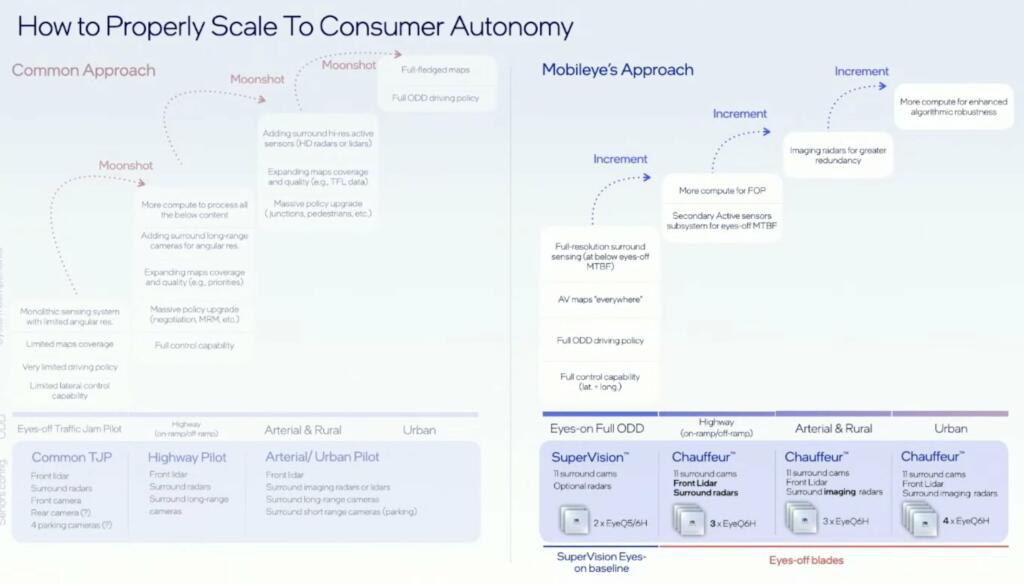Mobileye presented their self-driving and driver-assist technology at the 2023 CES. Mobileye wants to change the terminology from level one to level to a user-based terminology.
Mobileye Supervision and incremental improvement is like the incremental and profitable Tesla approach with Autopilot and FSD.
Tesla’s FSD beta is already “eyes-on, hands-off” with 285,000 users for the past month and Tesla autopilot has millions of users driving billions of miles per year.
All of Mobileye’s systems require high-definition maps in all areas of operation. Mobileye also requires lidar and more sensors for higher level of capability.
Mobileye will use REM technology to have all deployed cars feeding back high-definition maps in a crowdsourced method.

Mobileye has the chips, software and cameras for different levels of driver assist and they are working on higher levels of self-driving.
Mobileye’s SuperVision “eyes-on, hands-off” system is seeing strong customer demand in China, where more than 70,000 Zeekr 001 EV owners will soon get an additional over-the-air update that unlocks key mapping-based features. SuperVision will also be included in the upcoming Zeekr 009, along with near-term global launches on models from three other brands under the Geely Group umbrella.
By combining a camera-only sensing system with Mobileye’s key mapping and decision-making technology, SuperVision gives automakers an affordable, flexible platform for eyes-on, hands-off driving across a range of operational design domains.
The system’s success and speed-to-market in China’s highly competitive automotive landscape has driven new business wins for SuperVision-based systems around the world. Mobileye has kicked off development work with a premium European automaker for programs targeting delivery in 2025, with other customers at advanced stages of development. Overall, Mobileye now expects volume of SuperVision based vehicles to reach about 1.2 million units in 2026.


SuperVision as a bridge to enable eyes-off autonomous functions – comparable to SAE Level 3 and Level 4 – across a variety of operational design domains. This can be done by simply adding additional sensing suites and computing power in a modular way to create a high-value, cost-efficient, eyes-off product for consumer-owned vehicles in the medium term.
Mobileye now sees a revenue pipeline of ADAS business through 2030 of greater than $17 billion – including $3.5 billion of projected revenue from SuperVision alone, a product that was only launched in the fourth quarter of 2021. Thanks to other new products like EyeQ6™ system-on-chip, the pipeline grew impressively over the course of 2022 as Mobileye added $6.7 billion projected revenue in ADAS, across projected future volume of 63.6 million systems.
In addition to ADAS, Mobileye announced an additional $3.5 billion in expected revenue from Autonomous Mobility-as-a-Service products through 2028, based on deals with three major partners.






German Self-driving Pilot With Safety Driver
Continued progress on Mobility-as-a-Service technology and validation [Working to Robotaxi].
Beyond SuperVision and consumer-owned AVs, Mobileye has continued to develop its Mobileye Drive mobility-as-a-service (MaaS) autonomous vehicle technology in 2022. We recently signed an MOU for several thousand units with a major global producer of light commercial vehicles. In 2023, Mobileye will continue testing its AV tech, with pilots of our latest vehicle technology hitting the road in Germany.
In 2023, Mobileye has taken a key step on the road to the autonomous future of mobility: Mobileye obtained a permit recommendation from TÜV SÜD, an independent third-party for testing, certification, auditing and advisory service in Germany, enabling Mobileye to operate its AV technology on German streets. The permit makes way for Mobileye to expand the pilot phase in Germany and operate Mobileye Drive™-equipped NIO ES8s with a responsible safety driver on all roads in Germany.
The NIO ES8 is retrofitted with a broad range of sensors and Mobileye’s own autonomous self-driving system Mobileye Drive™ for a defined operational design domain (“ODD”). A set of 13 cameras, plus an independent secondary perception system consisting of six surround radars and three long-range and six short-range surround lidars gives the self-driving vehicle redundant sensing capabilities (we call this approach True Redundancy™). The EyeQ™ System-on-Chip (SoC) provides the necessary computing power to not only process the real-world data but also to make use of Mobileye’s Road Experience Management™ (REM™) – AV maps – and lean driving policy with the mathematical model for automated driving we call Responsibility-Sensitive Safety™ (RSS™).
Mobileye is taking the next step in realizing new mobility concepts in Germany and beyond. NIO’s ES8 was chosen by Mobileye in 2021 as the vehicle platform for Mobility-as-a-Service (MaaS) offerings underway with various partners in Munich and Darmstadt, as well as in other projects around Europe. NIO ES8s equipped with Mobileye’s self-driving hardware and software are planned to be used in a robotaxi service as well as in the integration of on-demand shuttles into local public transport in Germany. Following the regulations adopted by European Union and German authorities for safe autonomous driving (AV) testing and deployment in 2022, the pilot stage for these services on German roads will accelerate throughout 2023. A safety driver will be behind the wheel until all needed approvals and permits are obtained for the vehicle to be entirely unmanned.





Brian Wang is a Futurist Thought Leader and a popular Science blogger with 1 million readers per month. His blog Nextbigfuture.com is ranked #1 Science News Blog. It covers many disruptive technology and trends including Space, Robotics, Artificial Intelligence, Medicine, Anti-aging Biotechnology, and Nanotechnology.
Known for identifying cutting edge technologies, he is currently a Co-Founder of a startup and fundraiser for high potential early-stage companies. He is the Head of Research for Allocations for deep technology investments and an Angel Investor at Space Angels.
A frequent speaker at corporations, he has been a TEDx speaker, a Singularity University speaker and guest at numerous interviews for radio and podcasts. He is open to public speaking and advising engagements.


I think the SAE levels make more sense because they show the real safety and utility of each vehicle.
However, the legislation also allowed for authorities to monitor all cross-border communication without a warrant.